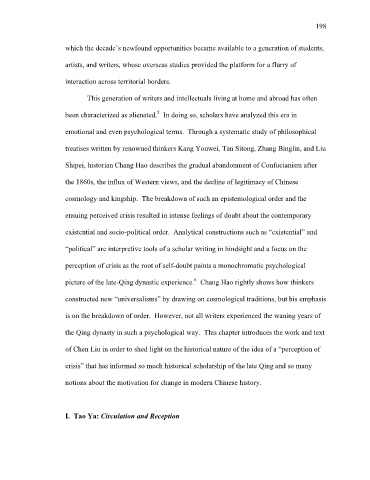Page 215 - Jindezhen Porcelain Production of the 19th C. by Ellen Huang, Univ. San Diego 2008
P. 215
198
which the decade’s newfound opportunities became available to a generation of students,
artists, and writers, whose overseas studies provided the platform for a flurry of
interaction across territorial borders.
This generation of writers and intellectuals living at home and abroad has often
5
been characterized as alienated. In doing so, scholars have analyzed this era in
emotional and even psychological terms. Through a systematic study of philosophical
treatises written by renowned thinkers Kang Youwei, Tan Sitong, Zhang Binglin, and Liu
Shipei, historian Chang Hao describes the gradual abandonment of Confucianism after
the 1860s, the influx of Western views, and the decline of legitimacy of Chinese
cosmology and kingship. The breakdown of such an epistemological order and the
ensuing perceived crisis resulted in intense feelings of doubt about the contemporary
existential and socio-political order. Analytical constructions such as “existential” and
“political” are interpretive tools of a scholar writing in hindsight and a focus on the
perception of crisis as the root of self-doubt paints a monochromatic psychological
6
picture of the late-Qing dynastic experience. Chang Hao rightly shows how thinkers
constructed new “universalisms” by drawing on cosmological traditions, but his emphasis
is on the breakdown of order. However, not all writers experienced the waning years of
the Qing dynasty in such a psychological way. This chapter introduces the work and text
of Chen Liu in order to shed light on the historical nature of the idea of a “perception of
crisis” that has informed so much historical scholarship of the late Qing and so many
notions about the motivation for change in modern Chinese history.
I. Tao Ya: Circulation and Reception

